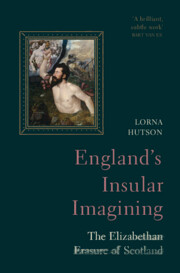Book contents
- England’s Insular Imagining
- England’s Insular Imagining
- Copyright page
- Contents
- Plates
- Abbreviations
- Acknowledgements
- Introduction
- Chapter 1 Writing the Forgotten War I: Henry’s War, 1542–1547
- Chapter 2 Writing the Forgotten War II: Somerset’s War, 1547–1550
- Chapter 3 How England Became an Island: The Faerie Queene
- Chapter 4 Scotland sui juris? Scottish Literature and the Marian Constitutional Crisis, 1567–1573
- Chapter 5 On the Knees of the Body Politic: Scottish Succession and English Liberties, 1567–1608
- Chapter 6 Scotland Un-kingdomed: English History on Stage
- Chapter 7 Race-Making in the Invention of Britain: The Masque of Blackness
- Chapter 8 Divisions and Kingdoms: Oedipal Britain from Gorboduc to King Lear
- Coda: Macbeth. ‘Alas, poor country’
- Works Cited
- Index
- Plate Section (PDF Only)
Chapter 3 - How England Became an Island: The Faerie Queene
Published online by Cambridge University Press: 28 September 2023
- England’s Insular Imagining
- England’s Insular Imagining
- Copyright page
- Contents
- Plates
- Abbreviations
- Acknowledgements
- Introduction
- Chapter 1 Writing the Forgotten War I: Henry’s War, 1542–1547
- Chapter 2 Writing the Forgotten War II: Somerset’s War, 1547–1550
- Chapter 3 How England Became an Island: The Faerie Queene
- Chapter 4 Scotland sui juris? Scottish Literature and the Marian Constitutional Crisis, 1567–1573
- Chapter 5 On the Knees of the Body Politic: Scottish Succession and English Liberties, 1567–1608
- Chapter 6 Scotland Un-kingdomed: English History on Stage
- Chapter 7 Race-Making in the Invention of Britain: The Masque of Blackness
- Chapter 8 Divisions and Kingdoms: Oedipal Britain from Gorboduc to King Lear
- Coda: Macbeth. ‘Alas, poor country’
- Works Cited
- Index
- Plate Section (PDF Only)
Summary
Chapter 3 engages with literary criticism’s argument that English national imagining became increasingly spatialised under Elizabeth Tudor. Critics argue that cartography and chorography introduced a new spatial awareness into English national consciousness. This criticism, which ignores Scotland, misrecognises as merely ‘national’ the imperial connotations of ‘British’ in the sixteenth century. The chapter shows that sixteenth-century chorographic British antiquarianism is shot through with both nostalgia and imperial ambition: ancient place-names and local legends fill the idea of England with the immanent presence of the British past and the promise of a pan-insular, imperial future. John Dee’s claims for English sea sovereignty over the Arctic and the Americas depended on claims to Scotland. Chapter 2 shows how Spenser’s The Faerie Queene conjures the vision of an Anglo-British imperial island in which Scotland becomes inconceivable. Spenser fuses river poetry, chorography and classical poetry with these texts on naval power, maritime law and English sea-sovereignty to shape the love of Florimell and Marinell as an allegory of Chastity as key to English insular empire.
Keywords
- Type
- Chapter
- Information
- England's Insular ImaginingThe Elizabethan Erasure of Scotland, pp. 69 - 115Publisher: Cambridge University PressPrint publication year: 2023



